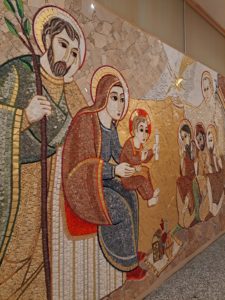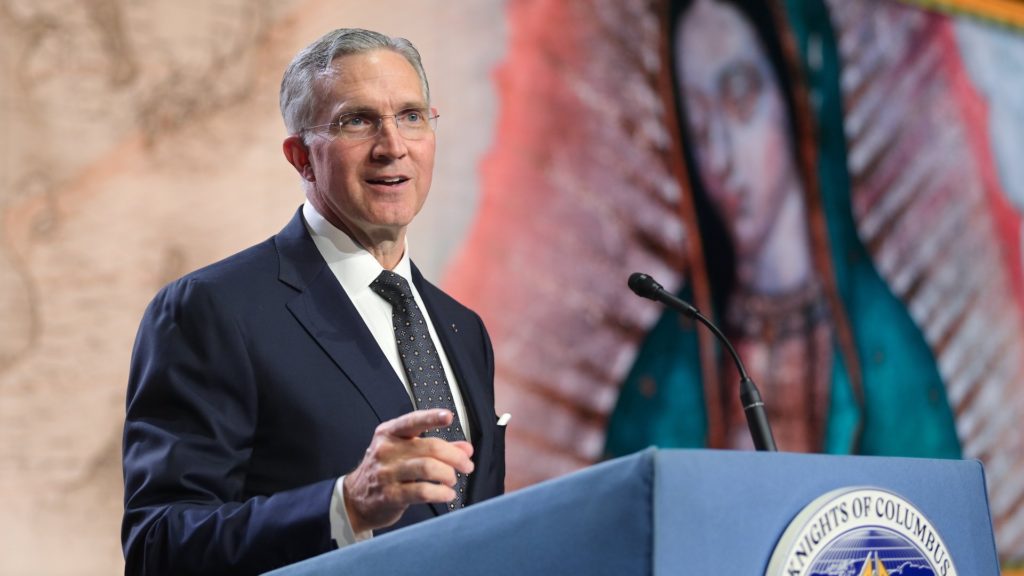The Knights of Columbus announced Thursday it will cover mosaics by the accused abuser Father Marko Rupnik in Washington, D.C., and Connecticut, a dramatic move that represents the strongest public stand yet by a major Catholic organization regarding the former Jesuit’s embattled art.
The 2.1-million-member lay Catholic fraternal order said July 11 it would use fabric to cover the floor-to-ceiling mosaics in the two chapels of the St. John Paul II National Shrine in Washington and in the chapel at the Knights’ headquarters in New Haven, Connecticut — at least until the completion of a formal Vatican investigation into the Slovenian priest’s alleged abuse.

Patrick Kelly, Supreme Knight of the Knights of Columbus, told EWTN News Thursday the opaque material would be installed “very soon” but gave no firm timetable. The Knights said in a statement released Thursday afternoon that the artwork may later be more permanently hidden with a plaster covering after the Dicastery for the Doctrine of the Faith issues its ruling on Rupnik.
The decision by the Knights to cover the sprawling works, which envelop both spaces, was made at the end of a comprehensive, confidential review process that included consultations with sexual abuse victims and those who minister to them, art historians, pilgrims to the shrine, bishops, and moral theologians.
“The Knights of Columbus have decided to cover these mosaics because our first concern must be for victims of sexual abuse, who have already suffered immensely in the Church, and who may be further injured by the ongoing display of the mosaics at the shrine,” Kelly said in the statement.
“While opinions varied among those consulted,” he said, “there was a strong consensus to prioritize the needs of victims, especially because the allegations are current, unresolved, and horrific.”
Kelly reiterated that point in his interview with EWTN News.
“Our decision process really came down to multiple factors. But the No. 1 factor was compassion for victims,” Kelly said. “We needed to prioritize victims over anything, any material thing. So that was our primary consideration.”
The first segment of Kelly’s interview with EWTN News will air on “EWTN News Nightly” Thursday at 6 p.m. and 9 p.m. ET. Additional comments will air on “EWTN News In Depth” on Friday at 8 p.m. ET.
Once a renowned artist Rupnik, whose mosaics are featured in hundreds of Catholic shrines, churches, and chapels around the world, was expelled from the Jesuits in June 2023.
His expulsion followed a long review of what the society called “highly credible” accusations of serial spiritual, psychological, and sexual abuse of as many as 30 religious sisters by the priest spanning decades. Some women allege Rupnik’s abuse sometimes happened as part of the process of creating his art at the Centro Aletti, an art school he founded in Rome.
The Vatican announced in late October 2023 that Pope Francis had waived the statute of limitations in the Rupnik case, allowing the Dicastery for the Doctrine of the Faith to do a canonical investigation into the abuse allegations.
There has been no further communication from the Vatican about the inquiry, and it is unclear whether Rupnik may still be living in Rome despite having been given priestly faculties in a diocese of his home country of Slovenia last year.
Growing public outcry
What to do with Rupnik’s once widely-praised works, colorful mosaics characterized by grand, flowing figures and large eyes, has proven to be a divisive question in the wake of the numerous allegations against him, which first came to public attention in December 2022.
While some want to await Vatican judgment before dismantling and replacing Rupnik’s works, much of it made in collaboration with other artists of the Centro Aletti — a Rupnik-founded art school and theological center in Rome — the public outcry for the removal of his art has intensified.
The Knights also announced several immediate changes that would be enacted at the shrine in solidarity with abuse victims, including providing educational materials about the mosaics, making clear that their display during the consultation process “was not intended to ignore, deny, or diminish the allegations of abuse.”
Every Mass at the St. John Paul II National Shrine will now also include a prayer of the faithful for victims of sexual abuse, and saints with connections to abuse victims, such as St. Josephine Bakhita, will be specially commemorated.
The group said it became aware of the allegations against Rupnik in December 2022 — and noted that the artist, while under investigation, remains a priest in good standing in the Diocese of Koper, Slovenia.
“This decision is rooted in a foundational purpose of the Knights of Columbus, which is to protect families, especially women and children, and those who are vulnerable and voiceless,” Kelly said in the July 11 statement.
The St. John Paul II National Shrine is a pastoral initiative of the Knights of Columbus, established in 2011, and designated a national shrine by the U.S. Catholic bishops in 2014.
Rupnik’s mosaics were installed at the shrine in 2015. The Holy Family Chapel at the Knights’ headquarters has featured Rupnik’s art since 2005.
Highlighting the John Paul II shrine’s mission of evangelization, the supreme knight said, “the art we sponsor must therefore serve as a stepping stone — not a stumbling block — to faith in Jesus Christ and his Church.”
Rupnik has not made any statements since the allegations came to light.
An eye on Lourdes
The Knights’ move to conceal the mosaics follows just a week after the bishop of Lourdes, France, said that despite his personal feelings that Rupnik’s artwork at the renowned Marian shrine there should be removed, he has decided to wait to make a final decision due to “strong opposition on the part of some.”
After forming a special commission in May 2023, Bishop Jean-Marc Micas of Tarbes announced July 2 that more time was needed “to discern what should be done” about Rupnik’s mosaics at the Marian apparition site, because his belief that they should be torn down “would not be sufficiently understood” and “would add even more division and violence” at this time.
As a “first step,” the French bishop said he had decided the mosaics will no longer be lit up at night during the shrine’s nightly candlelight rosary processions.
National Catholic Register Editor-in-Chief Shannon Mullen contributed to this story.

